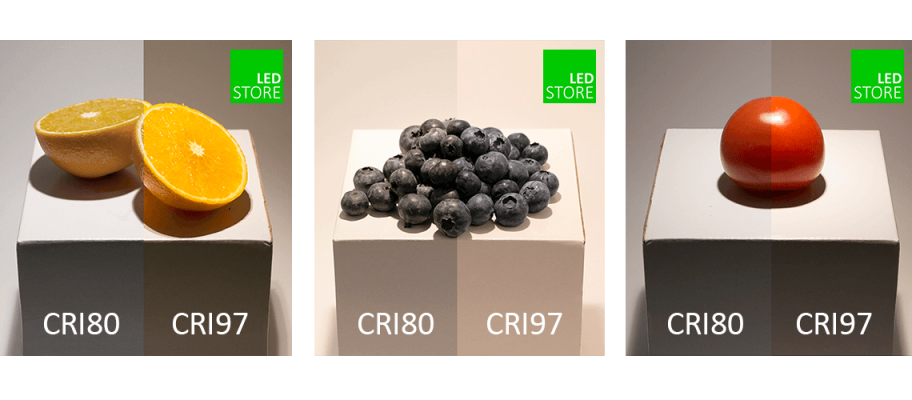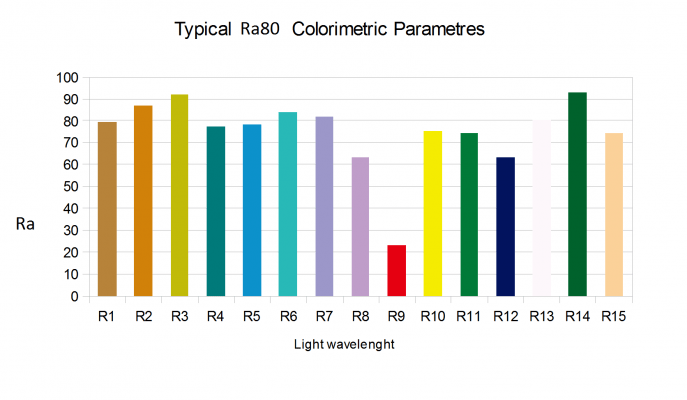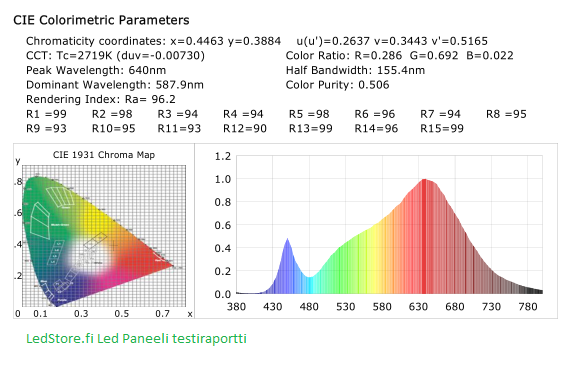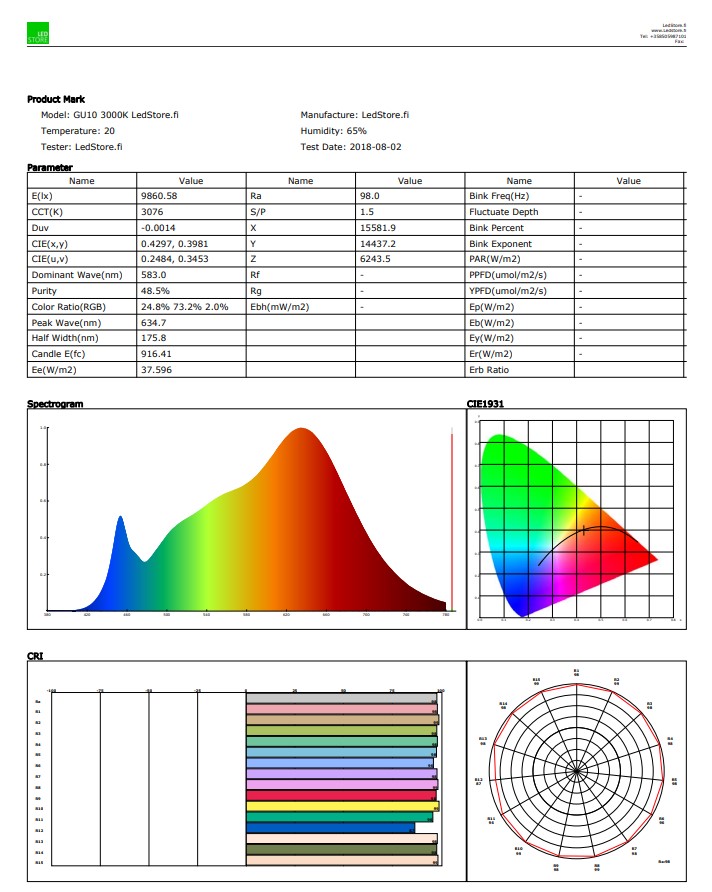What is the colour rendering index?
The colour rendering index tells us how well an LED lamp displays colours as they really are. The colour rendering index ( CRI) is a number that measures the ability of a light source to reproduce colours compared to a reference light source. The CRI figure is the TOTAL spectral range of all colours (on a scale of 1-15).

What is the value of RA?
The RA value is PART of the light produced by the light source. When measuring the luminous efficacy of a luminaire, the CRI measures all of the R1 to R15 colour ranges, but the RA value measures only the blue-green areas of the luminaire, R1 to R8. It is therefore important to note that if only the RA figure is given for a luminaire, it gives no indication of the luminaire’s ability to produce warm tones. The ultimate breakthrough of LED lighting has been hampered by its poor ability to produce the colours of the illuminated object, according to critics. This manifests itself as a bluish light or greyish colour. We often hear about pale people and hospital operating theatres in the context of LED lighting. The most difficult colour for an LED circuit to reproduce is red (R=9).
What is the difference between CRI and RA?
RA = R1-R8 (blue-green colours)
CRI = R1-R15 (all colours)

Find more information in our Blog!
Typical CRI requirements
Office lighting
Office lighting should be recommended to have a minimum CRI of 85, but CRI 90 is the minimum in our opinion. In the office, we work long hours with concentration, and good quality light helps our eyes to work. Typically 4000K colour temperature.
Video photography lighting
For videography lighting the requirement is for maximum colour rendering performance and CRI LED 100, but with a minimum CRI of 95. This way, the video camera gets all the colours recorded correctly. Often video lighting is also colour temperature adjustable.
Photographic lighting
For photographic lighting the requirement is for maximum colour rendering and CRI LED 100, but with a minimum CRI of 95. This way, the camera gets all the colours recorded correctly. Often photographic lighting is also colour temperature adjustable.
Home lighting
Home lighting should have a minimum recommended CRI of 85, but CRI 90 is the minimum in our opinion. This is because if you spend a lot of time at home, the light should be as natural as possible, preferably the same colour as in the shop. The colour temperature varies according to the room. Often also colour temperature adjustable.
Industrial lighting
Office lighting should have a minimum CRI of 70, but as robotics becomes more common, more light is also required for AI to see better. Even in the case of manufacturing, the CRI 90 standard is raised. Typically 4000K colour temperature.
Colour temperature is different from colour rendering
Colour temperature measures the temperature of white light. A traditional incandescent bulb is typically 2700K (yellowish), an office light 4000K (white), outdoors in Finland 5500K-11000K (bluish). These are COLOURED AIR CONDITIONS. So colour temperature is different from colour rendering. So colour temperature is how the eye perceives the colour of light. If the luminaire has good colour rendering it can still produce warm tones in 4000K light even if the light is white.
Good colour reproduction means a lot. It’s nice to see the right shades when putting on make-up or cooking, or to know what colour clothes or furniture really are. In addition, in low light, the mind becomes apathetic, and something seems wrong even when the lights are on.
CRI 100 LED, is there such a thing?
The CRI is expressed as a number on a scale from zero to 100, where 0 = no colour reproduction and 100 = full colour reproduction. The colour rendering index can also be negative. The colour rendering index does not indicate the colour of the light, but the colour temperature, measured in Kelvin. CRI 100 LED is a theoretical maximum, which means that it reproduces all colours. There are many luminaires in the LedStore range that easily exceed CRI 90, but most of them, e.g. Led strip with CRI 95 or even CRI 98 can be found in the range. Led spots are all CRI 98, led panels CRI 95, etc..
Lamps with a colour rendering index above 85 are generally perceived as quite natural. Light below CRI 80 is perceived as unnatural or coloured, or certain objects look strange in the light. The higher the CRI value, the more natural the colours look. In the past, high colour rendering was only the prerogative of professionals and those working with colour, but today high colour rendering index is available for all home lighting at a reasonable price. The weakness of bulk LED luminaires is still their poor colour rendering (CRI 60-80). And be careful, as Ra90 can be Cri70, as natural and red tones are not within the range of Ra. We indicate the correct CRI value on our products!
CRI of LedStore luminaires
LedStore offers new innovations and LED luminaires, with features previously only seen in the most expensive products now available to all. LedStore offers LED lamps with good colour rendering for everyone – everyday luxury for every home! CRI 90 LED has been a matter of course for us for years and high CRI LED is LedStore’s trademark for light quality. We have worked for years to ensure that the LED lights in our range exceed these basic requirements for us. Here are the CRI figures for our range:
- LED panels and ceilings CRI 93 – 98
- LED bulbs CRI 95 – 98
- LED spotlights CRI 95 – 98
- LED strip CRI 95 – 98
- LED track lighting CRI 90
So as you noticed, CRI 100 LED is practically a big part of our range.
Below is an example of a LedStore LED panel with a very high CRI (colour rendering index). We aim to include the measurement results of CRI values for all luminaires as a downloadable a file.

While this work is in progress , here is a sample CRI report of our top quality GU10 bulbs. The bottom left shows 15 horizontal bars, all of which are close to the 100-point level. The CRI of this bulb is 98. The colour temperature of the light is 3 076K, in the 3000K range.

Colour rendering index CRI, but not the same as Ra number
This category contains virtually all our luminaires, as we focus on CRI 90+ luminaires.
